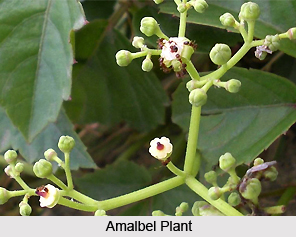 The Fox Grape tree bearing the scientific name Cayratia Trifolia Domin has many other common names. In Bengali it is called amallata, bundal while in Gujarati it is called khat, khatumdu, tamanya. In Hindi the tree is named amalbel and in Kannada it is called heggoli. In other languages such as Punjabi it is called drukri, gidardak. karik, in Sanskrit amlaparni, atyamlaparni, in Tamil kurudinna, tumans and in Telegu kam-putige, kurudinne. The Fox Grape tree is a native of the Asian tropics from India and Sri Lanka to southern China, Indochina and Malaysia. The tree is widely found throughout the hotter parts of India, including all of peninsular India up to 600 m elevation.
The Fox Grape tree bearing the scientific name Cayratia Trifolia Domin has many other common names. In Bengali it is called amallata, bundal while in Gujarati it is called khat, khatumdu, tamanya. In Hindi the tree is named amalbel and in Kannada it is called heggoli. In other languages such as Punjabi it is called drukri, gidardak. karik, in Sanskrit amlaparni, atyamlaparni, in Tamil kurudinna, tumans and in Telegu kam-putige, kurudinne. The Fox Grape tree is a native of the Asian tropics from India and Sri Lanka to southern China, Indochina and Malaysia. The tree is widely found throughout the hotter parts of India, including all of peninsular India up to 600 m elevation.
Fox Grape has perennial climber with stems up to 7 m long and 4.5 cm in diameter. The stems of the tree are woody at the base only. The leaves are alternate, trifoliate and have common petioles which are 2-4.5 cm long. The tendrils are slender and the leaflets are thick, generally 3.8-5.7 cm long and 2.2-3.2 cm wide. The tree bearing the flowers are branched which are pubescent having long-peduncled axillary or terminal cymes to 8 cm long and broad. They are usually funnel-shaped, obscurely 4-lobed usually having four petals. The fruits i.e. the berries are white in colour. They are 1.2-2 cm long, having 2-4 seeds in them. They are generally triangular in shape and rounded and rugose on the back
Medicinal Properties of Fox Grape
Fox tree has various medical properties. The astringent roots of the tree grounded with black pepper can be applied to boils. In Ayurveda they are used to treat tumours, pains and spleen complaints. Its paste is useful in reducing lymphatic swellings. This technique is used by the Kolams of Andhra Pradesh. A fomentation prepared with a hot decoction of leaves or roots is considered diaphoretic and is useful during high fevers.
This article is a stub. You can enrich by adding more information to it. Send your Write Up to content@indianetzone.com



















